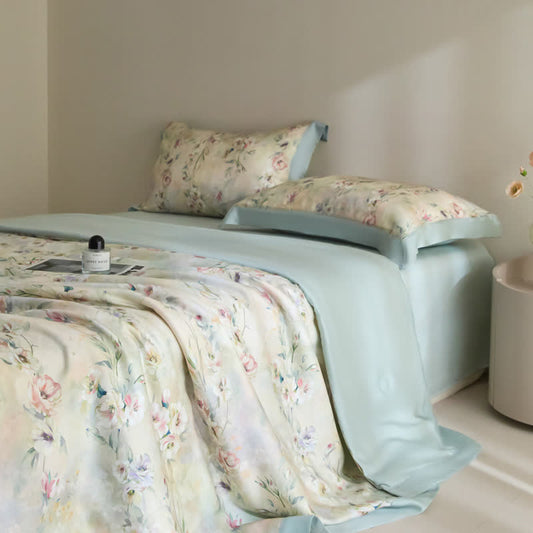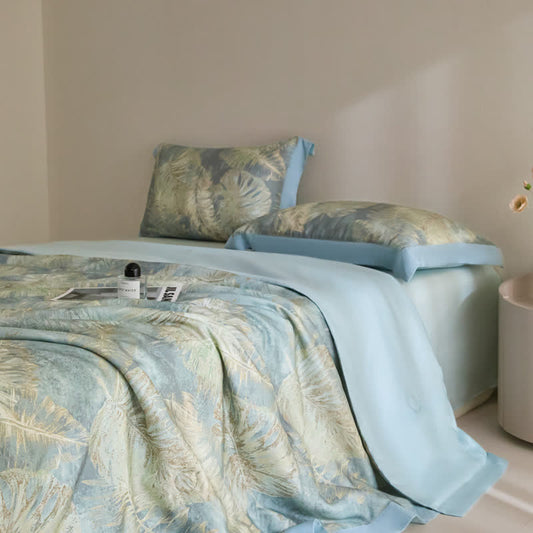FAQs
What is lyocell fiber and how is it made?
Lyocell fiber is a sustainable fabric made from wood pulp, typically sourced from eucalyptus, beech, or spruce trees. The manufacturing process of lyocell fiber uses a closed-loop system, meaning the water and solvents used to produce the fiber are almost entirely recovered and reused. This environmentally friendly method reduces waste and energy use, making lyocell fiber a greener alternative to traditional textiles.
Because of its smooth surface and natural origin, lyocell fiber is soft, breathable, and gentle on the skin. Lyocell fiber is also biodegradable and compostable, adding to its eco-conscious appeal. Due to these properties, lyocell fiber is widely used in bedding, clothing, and towels, offering a luxurious feel with minimal environmental impact.
Is lyocell fiber better for sensitive skin?
Yes, lyocell fiber is an excellent choice for individuals with sensitive skin. Unlike synthetic fabrics, lyocell fiber is naturally smooth and hypoallergenic, which means it won’t irritate or cause friction against delicate skin. The moisture-wicking properties of lyocell fiber help keep the skin dry, reducing the risk of bacterial buildup and skin irritation.
Many dermatologists recommend lyocell fiber bedding for those with eczema or allergies. Since lyocell fiber is free from harsh chemicals and processed using non-toxic solvents, it’s safer and more skin-friendly than other common materials. Choosing lyocell fiber bedding ensures comfort and protection, especially during warm nights when skin sensitivity can worsen.
How durable is lyocell fiber compared to other fabrics?
Lyocell fiber is known for its impressive durability despite its soft and luxurious feel. Compared to traditional cotton or bamboo, lyocell fiber has a higher tensile strength, meaning it resists tearing and stretching over time. This makes lyocell fiber bedding a long-lasting investment, especially for those who value both performance and comfort.
Additionally, lyocell fiber maintains its strength when wet, unlike many natural fabrics that weaken with moisture. This feature allows lyocell fiber products to withstand frequent washing without losing shape or softness. Whether used in sheets, pillowcases, or quilts, lyocell fiber bedding delivers durability without sacrificing a silky touch.
Can lyocell fiber bedding help regulate body temperature?
Lyocell fiber bedding is highly effective at regulating body temperature, making it ideal for hot sleepers or fluctuating climates. The fabric’s unique structure allows it to absorb excess moisture and release it quickly, creating a cooling and dry sleep environment. This makes lyocell fiber a popular material for summer quilts and breathable sheets.
Unlike synthetic fabrics that trap heat, lyocell fiber is naturally breathable and promotes airflow. Lyocell fiber bedding helps prevent overheating during summer nights while still offering light insulation when temperatures drop. For those who experience night sweats or live in warm regions, lyocell fiber bedding is a smart and comfortable solution.
What materials are best for summer bedding to stay cool?
The best materials for summer bedding are those that are breathable, moisture-wicking, and lightweight. Lyocell fiber bedding stands out among them due to its exceptional temperature-regulating properties. It absorbs moisture efficiently and allows heat to dissipate, keeping you cool throughout the night. Other good options include cotton, bamboo, and linen, but lyocell fiber bedding offers a smoother feel and is especially gentle on sensitive skin.
In hot weather, lyocell fiber bedding provides a comfortable alternative to heavy sheets and blankets. Its natural ability to manage humidity makes it a favorite for summer bedding use. For those prone to overheating or night sweats, switching to lyocell fiber bedding can significantly improve sleep quality. Look for lyocell fiber sheets, pillowcases, and lightweight quilts for a full cooling sleep system.
How do I choose the right summer bedding for hot climates?
Choosing the right summer bedding for hot climates involves selecting lightweight, breathable, and moisture-wicking fabrics. Lyocell fiber bedding is an excellent choice as it excels in all these aspects. It keeps the body cool and dry by absorbing sweat and promoting airflow, reducing discomfort during hot and humid nights. Consider lightweight quilts or duvet inserts made from lyocell fiber to avoid trapping heat.
Additionally, focus on light colors and lower thread counts, as these enhance breathability. Lyocell fiber bedding not only helps regulate temperature but also feels silky and smooth, adding a touch of luxury to your summer bedding setup. Whether it’s a fitted sheet, flat sheet, or quilt cover, lyocell fiber bedding offers both comfort and functionality in warm climates.
How often should summer bedding be washed during hot months?
During hot months, summer bedding should be washed more frequently due to increased sweating and humidity. Ideally, lyocell fiber bedding should be washed once a week to maintain hygiene and freshness. Lyocell fiber has strong moisture-wicking abilities, which means it can absorb body oils and sweat, making regular cleaning essential to avoid bacterial growth and skin irritation.
Despite its softness, lyocell fiber bedding is durable and can withstand frequent laundering without pilling or fading. Be sure to wash lyocell fiber bedding in cool water with mild detergent and avoid high-heat drying. This will help preserve the fabric's natural softness and structure while ensuring your summer bedding remains clean and breathable all summer long.
What is the difference between a summer quilt and a regular quilt?
A summer quilt is specifically designed for warm weather, featuring lightweight construction and breathable materials. Unlike regular quilts that are thick and heavily insulated, a summer quilt typically uses fabrics like cotton, bamboo, or lyocell fiber to promote airflow and moisture control. This helps prevent overheating and night sweats during summer nights.
Lyocell fiber summer quilts are especially popular due to their cooling and moisture-wicking properties. While regular quilts are ideal for winter or cold climates, a lyocell fiber summer quilt offers a breathable, soft layer that enhances sleep comfort in hot conditions. Choosing the right quilt depends on climate, fabric, and individual comfort needs.
How to choose the best summer quilt for night sweats?
When dealing with night sweats, it’s essential to choose a summer quilt made from breathable, moisture-absorbing materials. Lyocell fiber bedding is one of the top choices for this need. A lyocell fiber summer quilt effectively pulls moisture away from the body and allows it to evaporate quickly, helping you stay cool and dry throughout the night.
In addition to being soft and lightweight, lyocell fiber bedding is also hypoallergenic and suitable for sensitive skin. Look for a quilt with a lyocell fiber filling or outer layer to maximize comfort and airflow. For hot sleepers or those with medical conditions that cause sweating, lyocell fiber bedding offers a practical and luxurious solution.
How to clean and store a summer quilt properly?
To clean a summer quilt properly, check the care label and follow specific instructions for the fabric. If your quilt is made with lyocell fiber, wash it in cold water with a gentle, non-bleach detergent. Lyocell fiber is strong but should be handled with care to maintain its softness and structure. Use a delicate cycle and air dry or tumble dry on low heat to avoid shrinkage.
When storing a lyocell fiber summer quilt, ensure it is completely dry to prevent mildew. Fold it loosely and place it in a breathable cotton bag or storage box, avoiding airtight plastic containers. This helps preserve the freshness and breathability of lyocell fiber bedding, so it’s ready for use again when warm weather returns.

















































